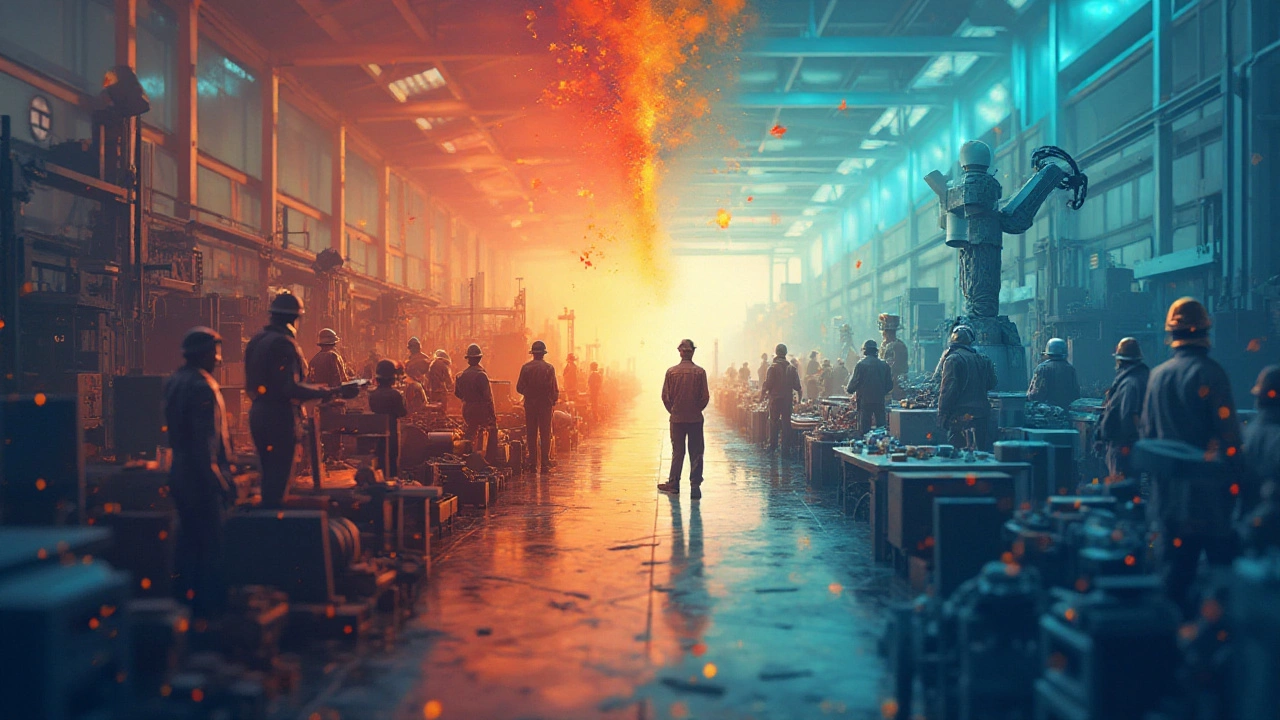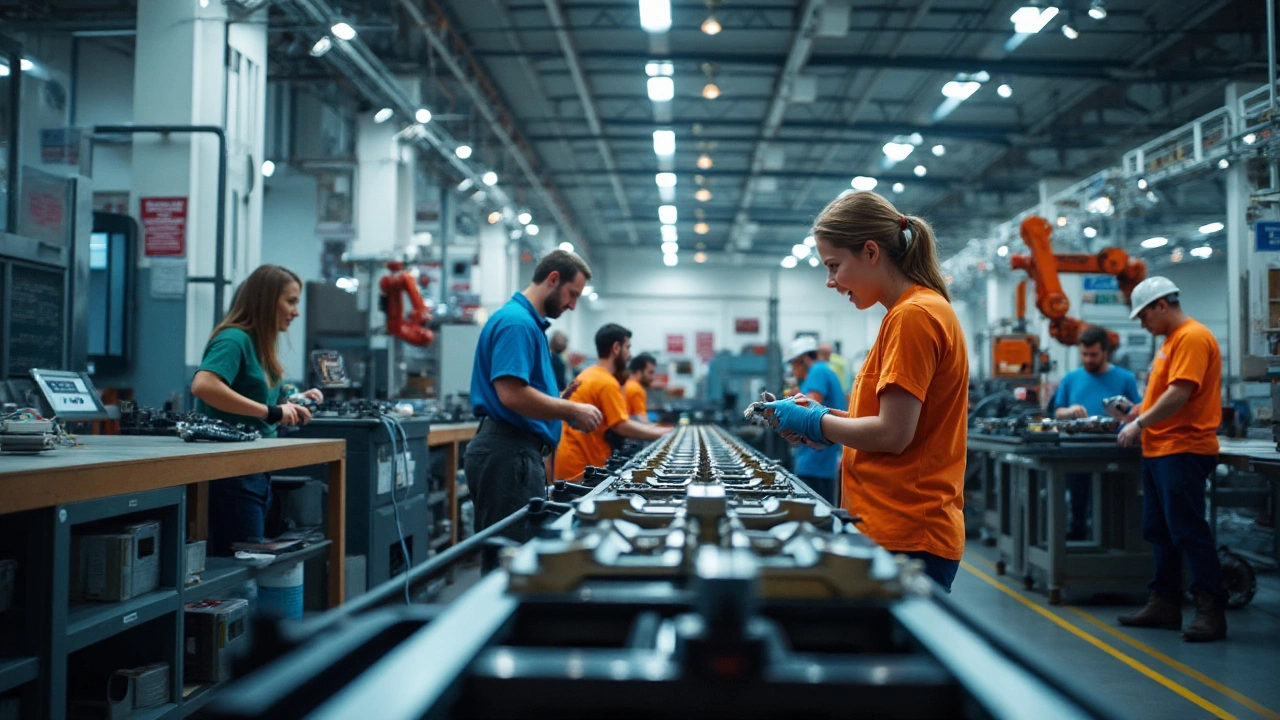The resurgence of manufacturing jobs in America has captured the attention of policymakers, economists, and the general public alike. This renewed interest is often driven by a desire to boost the economy, increase employment, and regain a competitive edge in global markets. The potential return of manufacturing jobs brings with it a complex set of factors to consider, including government incentives, the role of technology, and the pressure of international competition.
In recent years, several government initiatives have been introduced to entice manufacturers to establish or expand their operations within the United States. These schemes often include financial incentives, tax benefits, and funding for infrastructure projects. However, it's not just about luring companies back; it's also about preparing the workforce to meet the needs of modern manufacturing environments where technology plays a significant role.
As industries change, new challenges arise—such as balancing the efficiency brought by automation with the need to maintain employment levels. Coupled with the complexities of global trade dynamics, these factors shape the landscape for manufacturing in America today. Navigating these dynamics requires a strategic approach, thoughtful policy-making, and ongoing adaptation to the rapidly evolving economic landscape.
- Historical Context of Manufacturing in America
- Government Schemes and Incentives
- Impact of Automation and Technology
- Global Competition and Trade Policies
- Future Prospects and Challenges
Historical Context of Manufacturing in America
Manufacturing has been the backbone of the American economy since the industrial revolution, shaping not only economic landscapes but also societal structures. In the early days, America's industrial prowess was largely driven by its ability to convert untapped natural resources into products ranging from textiles to steel. The establishment of factories across the northeastern United States marked the beginning of a manufacturing boom, which was characterized by mass production techniques that revolutionized industries. Henry Ford's introduction of the assembly line in 1913 is one notable milestone that dramatically increased efficiency and output, setting a new standard for manufacturing processes worldwide. This era not only bolstered American prominence in global trade but also catalyzed urbanization, as people moved to cities in search of stable industrial jobs.
The post-World War II period saw an unprecedented expansion of manufacturing jobs, with America emerging as a global industrial leader. This era, often dubbed the 'Golden Age of Manufacturing', was characterized by abundant job opportunities, robust economic growth, and an emerging middle class. However, the landscape began to shift in the latter half of the 20th century as industries faced increased competition from abroad, particularly following trade liberalizations and the entry of Asian nations into the manufacturing sector. This competitive pressure coincided with rising wages and operating costs domestically, prompting many American companies to seek more cost-effective operations overseas.
By the late 20th century, the combination of technological advancements and global economic integration led to significant declines in domestic manufacturing employment. Factories that had once thrived became shadows of their former selves, and the economic viability of many American towns was severely tested. Despite these challenges, the United States continued to innovate, focusing on high-tech manufacturing and the production of sophisticated goods such as aerospace, medical devices, and advanced machinery.
Citing the words of historian David Nye, "Understanding the shifts in manufacturing is not only about economic metrics but also about revisiting the intricate tapestry of American industrial culture."
Looking into the 21st century, the sector has begun to experience a renaissance of sorts, partly driven by new technologies like automation, artificial intelligence, and 3D printing, which promise to revitalize domestic production capabilities. Various government initiatives aim to capitalize on this momentum by fostering a skilled workforce that can handle these cutting-edge technologies. Simultaneously, emphasis is being placed on ensuring resilience against global disruptions, intending to bring a significant number of manufacturing jobs back to American soil. While the journey is complex, the goal is clear: to reestablish America's manufacturing industry as a vital contributor to both economic prosperity and national security.
Government Schemes and Incentives
In an era defined by economic shifts and geopolitical challenges, the United States government has been actively rolling out initiatives to reinvigorate its manufacturing jobs sector. These measures are crucial for ensuring that America competes robustly on the global stage while also addressing domestic employment needs. By evaluating and implementing strategic policies, the government seeks to revitalize the industry that has long been seen as the backbone of the nation's economy.
One of the foremost initiatives is the provision of tax incentives aimed at encouraging companies to either relocate their manufacturing units back to America or expand existing facilities. These incentives often take the form of tax credits or deductions that significantly lower the financial burden on businesses. For instance, the Tax Cuts and Jobs Act has made it favorable for companies to reinvest in domestic production by offering reduced corporate tax rates.
Infrastructure development is another key focus area, as the government recognizes the pivotal role it plays in supporting industry growth. By investing billions into upgrading transportation networks, such as highways, railroads, and ports, the aim is to create a seamless supply chain that enhances efficiency and attracts manufacturers. Such infrastructure improvements not only benefit businesses but also generate jobs within the local communities where these projects are executed.
The government is also committed to fostering a skilled workforce capable of operating modern manufacturing technologies. Educational reforms and training programs are being rolled out at community colleges and technical institutes to equip people with the requisite skills. The emphasis on such programs is crucial, given the dynamic nature of the industry, where automation and sophisticated machinery are becoming increasingly common. As a part of these initiatives, collaborations between educational institutions and manufacturing firms are being facilitated to ensure practical training and job placements.
In certain cases, direct financial support is extended to companies keen on shifting their operations back to America. The 'ReShoring Initiative' is a standout example of this strategy, providing grants and loans specifically tailored to assist businesses in managing relocation costs. Such financial backing is necessary to counterbalance the initial expenses involved in relocating production facilities, which can otherwise be a deterrent for companies considering reshoring.
Despite these efforts, the government remains aware of the challenges posed by international trade policies and pressure from global competitors. To counteract these obstacles, the United States has engaged in discussions to establish favorable trade agreements that include protective measures for its industries. Such measures ensure that American-manufactured products remain competitive both at home and abroad. A report by the International Trade Administration highlights that these trade policies have already contributed to a noticeable uptick in domestic manufacturing output.
A notable quote from a recent symposium on manufacturing highlights the sentiment driving these initiatives:
"Rebuilding our manufacturing base is not merely an economic imperative but a strategic one, ensuring national resilience in uncertain times," noted a prominent policy advisor.As America continues to invest in building a resilient manufacturing framework, these schemes and incentives are foundational to creating a sustainable industrial resurgence.

Impact of Automation and Technology
The influence of automation and technology in the manufacturing jobs sector has been transformative, reshaping how industries operate across the globe. Automation, marked by the rise of robotics and advanced machinery, has led to significant efficiency gains, allowing companies to increase production speed while maintaining higher quality levels. However, this technological advancement has not come without its challenges. As machines become more capable, the demand for traditional blue-collar workers decreases, prompting a shift towards more specialized skills.
In the United States, approximately 88% of job losses in manufacturing from 2000 to 2010 were due to improved productivity enabled by technology, according to a study by the Center for Business and Economic Research. This statistic highlights the dual-edge nature of automation; while it boosts productivity, it also reduces the number of jobs available in traditional roles. The adoption of technologies like AI and IoT (Internet of Things) continues to revolutionize manufacturing processes, allowing for real-time monitoring and predictive maintenance, which reduces downtime and optimizes resource use.
The concept of Industry 4.0 encapsulates these changes, where cyber-physical systems, big data, and cloud computing enable smart manufacturing ecosystems. Implementing such advanced systems requires a workforce that is not only technically skilled but also adaptable to continuous learning and innovation. Consequently, education and training are becoming crucial focal points in the discussion about manufacturing industry evolution. As companies adopt these new technologies, there is an increasing need for workers who can program, maintain, and optimize these automated systems.
"The skills needed in manufacturing are changing. It's not just about producing goods; it's about adapting to new technologies and being able to work with them effectively," says John Smith, an expert in industrial engineering.
Despite the challenges, automation presents substantial opportunities. For instance, by reducing labor costs through automation, American companies may find it more economically feasible to repatriate some of their operations from overseas. Additionally, technology creates new job roles within the manufacturing ecosystem, such as robot maintenance technicians and automation specialists. Organizations and educational institutions are starting to recognize this shift and are beginning to develop programs that aim to bridge the skills gap, providing training in advanced manufacturing techniques.
Looking ahead, it is crucial for policymakers to understand the implications and costs related to automation, striving to implement strategies that leverage technology's advantages while mitigating its socio-economic impacts. Balancing these elements is vital to maintaining a competitive edge in the global market and ensuring that the American workforce remains robust and adaptive. Automation and technology can certainly pave the way for the return of manufacturing jobs to America, but only if coupled with efforts to coordinate education, training, and policy-making in unison.
Global Competition and Trade Policies
In the dynamic world of manufacturing, the landscape is shaped by economic forces that transcend borders. As the United States considers boosting its manufacturing jobs, it must carefully navigate the waters of global competition and implement effective trade policies. These two elements are crucial in defining the success or failure of reviving manufacturing in America. Understanding how countries around the world manage their manufacturing processes can provide valuable insights. For instance, countries like Germany and China have managed to sustain robust manufacturing sectors through a mix of government support, advanced technology adoption, and strategic global partnerships.
Trade policies are a vital tool in shaping the direction of manufacturing in America. Tariffs, trade agreements, and export controls are points of leverage that the government can use to influence the movement of goods and services across borders. These policies can either elevate domestic industries or expose them to stiff competition from abroad, depending on the balance struck. The recent renegotiation of the USMCA (United States-Mexico-Canada Agreement) is an example of how trade policies can be crafted to address the unique challenges of the manufacturing sector. By leveraging such agreements, the United States can create a protective yet competitive environment that benefits both local industries and consumers. The complexities of these policies require continual adjustment, addressing shifts in global market dynamics and emerging economic threats.
One of the significant hurdles in the manufacturing sector is the intense competition from Asian markets. China, in particular, commands a massive share of global manufacturing due to its low labor costs, extensive supply chains, and strong government support. American manufacturers often struggle to compete with these advantages unless similar structural supports are in place or unless they innovate in areas such as quality and speed of production. Trade policies need to address these disparities while ensuring compliance with international trade standards. According to the World Trade Organization, global trade policies can help in leveling the playing field, but it requires nations to cooperate and agree on fair practices and regulations.
"A nuanced approach to trade policies can provide the leverage required to enhance local manufacturing while remaining competitive on the global stage," states Ian Bremmer, a prominent political scientist and economist.
The strategic use of tariffs and trade barriers can act as a double-edged sword. While they can protect emerging industries and vital sectors from external competition, they're also capable of sparking trade wars that harm the very industries they aim to protect. This was evident during the recent tariff battles between the U.S. and China, where both nations imposed stiff tariffs on each other's goods, leading to increased costs for manufacturers and consumers alike. The need for agile and adaptable trade policy frameworks in such a complex environment is more apparent now than ever before.
Data supports the notion that thoughtfully designed trade policies lead to positive outcomes in job growth within the manufacturing sector. According to a study by the Economic Policy Institute, rethinking trade policies with a focus on reducing the trade deficit could create up to two million manufacturing jobs in America over the next decade. These jobs wouldn't just enhance economic stability but would also drive technological advancement and innovation through increased competition, thereby rejuvenating America's position in the global manufacturing arena.

Future Prospects and Challenges
As the conversation about reviving manufacturing jobs in America gains momentum, it is essential to look at what the future holds and the obstacles that may arise. In the coming years, the landscape of manufacturing is likely to be shaped by advancements in technology, evolving policies, and shifting market demands. Automation and artificial intelligence, for instance, are expected to redefine production processes, enabling higher efficiency but also posing risks to the traditional workforce roles. This dual-edged sword scenario presents both opportunities for growth and challenges in maintaining employment levels.
Government schemes aimed at supporting industry growth play a crucial role in shaping the future of manufacturing. Tax incentives and subsidies encourage companies to invest in innovative technologies and advanced manufacturing techniques. There's also a focus on upskilling the workforce, with investment in education and training programs designed to equip workers with the skills required for modern manufacturing environments. By emphasizing workforce development, America can better position itself against international competitors that are equally keen to capture a share of the global manufacturing market.
Yet, these efforts face hurdles, not least from global competition. Countries with lower production costs, such as China and Vietnam, continue to attract manufacturing investments. These nations benefit from lower wages and less stringent regulations, which can undercut American manufacturing efforts. Crafting effective trade policies that address these disparities without triggering a trade war remains a balancing act that policymakers must navigate. According to a 2023 report by the Economic Policy Institute, "the trade deficit in manufactured goods was $700 billion, highlighting the need for strategic policy intervention."
Another significant challenge is the rising call for sustainability in manufacturing practices. Companies are increasingly under pressure to adopt more environmentally responsible methods, which can require costly overhauls of facilities and processes. However, this shift also represents an opportunity for American manufacturers to stand out by setting global standards in sustainable production. By investing in green technologies and practices, companies not only contribute to environmental goals but also build a competitive edge that appeals to environmentally conscious consumers worldwide.
The road to revitalizing manufacturing in America is undoubtedly complex, requiring coordinated action across various fronts. From embracing cutting-edge technologies to developing meaningful government schemes and fostering international cooperation, the path is filled with both potential and pitfalls. As these dynamics continue to unfold, policymakers, industry leaders, and the workforce must stay adaptable, finding new ways to turn challenges into opportunities for sustainable, long-term growth.
